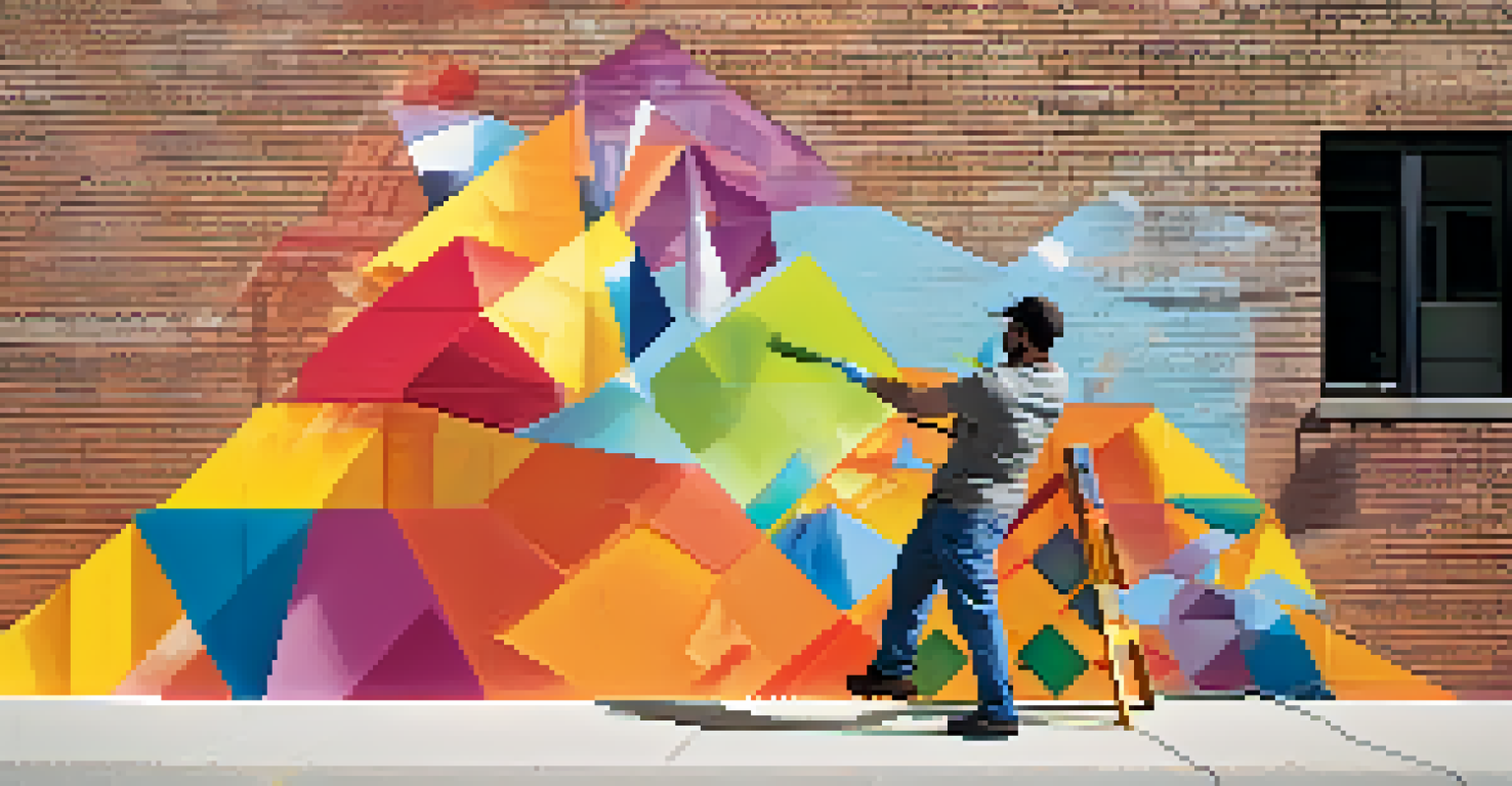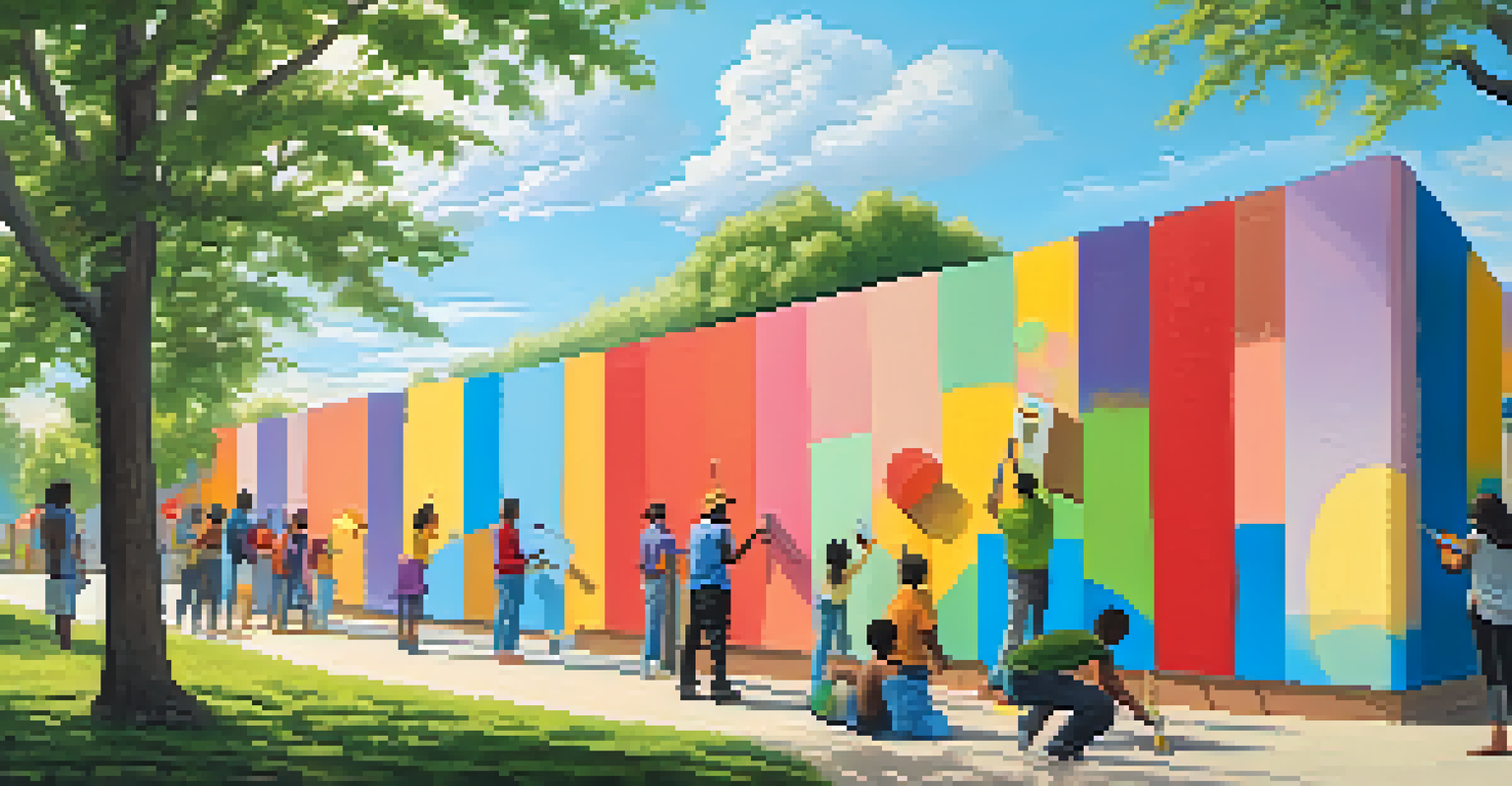The Evolution of Paint Rollers in Artistic Expression

The Birth of the Paint Roller: A Game Changer in Painting
The paint roller was first introduced in the 1940s, revolutionizing how we apply paint. Before its invention, artists and decorators relied heavily on brushes, which, while effective, were often time-consuming and labor-intensive. The ease of using a roller allowed for quicker application and a more uniform finish, making it an instant favorite among both professionals and DIY enthusiasts.
Art is not freedom from discipline, but disciplined freedom.
Paint rollers not only sped up the process of painting walls but also opened new avenues for artistic expression. With the ability to cover large areas efficiently, artists began experimenting with texture and layering in ways that a brush simply couldn't achieve. This shift laid the groundwork for a new era of creativity where speed and efficiency could coexist with artistry.
As the paint roller gained popularity, manufacturers started to innovate, creating various types of rollers designed for specific textures and finishes. This evolution meant that artists could now express their visions with greater flexibility, leading to more diverse applications of color and style.
Exploring Different Roller Types and Their Artistic Impact
From smooth foam rollers to textured fabric options, the variety of paint rollers available today caters to different artistic needs. Each type offers unique properties that can enhance or alter the painting experience. For instance, a fuzzy roller can create a textured finish, while a foam roller is ideal for achieving a smooth, sleek look.

Artists began to embrace these diverse rollers not just for their practical applications, but also for the creative possibilities they presented. By mixing and matching roller types, painters can produce intricate patterns and effects that add depth to their work. This experimentation reflects a growing trend of blending traditional techniques with modern tools.
Paint Rollers Revolutionized Art
The introduction of paint rollers in the 1940s transformed painting by allowing faster application and encouraging artistic experimentation.
Moreover, the accessibility of these various rollers has democratized art-making. More people can now engage in creative projects, using rollers to express their unique styles without needing extensive training or professional equipment. This shift has led to a resurgence in DIY and community art projects, invigorating local art scenes.
The Role of Paint Rollers in Street Art and Murals
In recent years, paint rollers have found a prominent place in the world of street art and murals. Their ability to cover large areas quickly allows artists to create bold statements in urban environments. Street artists often use rollers to achieve vibrant backgrounds or large-scale designs that capture the attention of passersby.
Every artist was first an amateur.
The intersection of traditional painting techniques with the practical use of rollers has been a driving force in the evolution of public art. Artists like Banksy and Shepard Fairey have utilized rollers to execute their visions rapidly, often in locations where time is of the essence. This adaptability has transformed how murals are created and perceived, making them more accessible to a broader audience.
Furthermore, the use of paint rollers in public art reflects a shift in artistic expression, where the message is often as important as the medium. This approach encourages community engagement and dialogue, inviting viewers to connect with the artwork on a deeper level while appreciating the skill involved in its creation.
Innovative Techniques: Layering and Stenciling with Rollers
The versatility of paint rollers has led to innovative techniques that push the boundaries of traditional painting. Artists have begun to experiment with layering colors using rollers, creating stunning visual effects that can transform a simple wall into a dynamic canvas. This method not only adds depth but also allows for the exploration of color theory in a tangible way.
Stenciling has also become a popular technique among roller users, enabling artists to incorporate intricate designs into their work. By applying paint over a stencil with a roller, they can achieve crisp edges and detailed patterns that would be challenging to replicate with a brush. This union of tools and methods has expanded the toolkit of contemporary artists, inviting more creativity in their projects.
Diverse Rollers Enhance Creativity
Different types of paint rollers enable artists to explore unique textures and effects, making art more accessible and encouraging community engagement.
Moreover, the layering and stenciling techniques provide an opportunity to engage with mixed media. Artists can combine rollers with spray paint, brushes, or even digital tools, creating unique pieces that reflect their individual styles and perspectives. This blending of techniques showcases the evolving nature of artistic expression and the endless possibilities that come with it.
Sustainability in Paint Roller Use: The Eco-Friendly Shift
As the art world becomes increasingly aware of environmental issues, the paint roller industry has also started embracing sustainability. Many manufacturers now produce rollers made from recycled materials or organic fibers, making them more eco-friendly options for artists. This shift reflects a broader trend in the creative community toward sustainable practices.
Artists have taken notice of this change, often opting for eco-friendly supplies that align with their values. By choosing sustainable rollers, they can reduce their environmental impact while still achieving desired artistic effects. This conscious choice empowers artists to use their craft as a platform for promoting sustainability and raising awareness about environmental issues.
Additionally, the rise of non-toxic paints further complements the eco-friendly roller movement. Artists can now create vibrant works without compromising their health or the environment. This combination of sustainable materials and practices not only enhances artistic expression but also contributes to a more responsible and mindful art culture.
The Future of Paint Rollers in Artistic Expression
Looking ahead, the future of paint rollers in artistic expression seems bright and full of potential. As technology continues to advance, we can expect to see even more innovative roller designs that enhance usability and creativity. Smart rollers equipped with sensors or digital interfaces may soon allow artists to achieve precise effects with ease.
Moreover, as art becomes more integrated with technology, we may see a fusion of traditional roller techniques with digital painting methods. This could open up new avenues for artistic exploration, where physical and digital mediums coexist and enrich each other. The possibilities are truly limitless as artists continue to embrace change and adapt to new tools.
Sustainability Shapes Future Art
The shift towards eco-friendly paint rollers reflects a growing awareness of environmental issues within the art community.
Ultimately, the evolution of paint rollers speaks to a broader narrative in the art world: the convergence of tradition and innovation. As artists experiment and push boundaries, paint rollers will undoubtedly play a crucial role in shaping the future of artistic expression, inspiring generations to come.
Conclusion: Celebrating the Artistic Journey of Paint Rollers
The journey of paint rollers from simple tools to essential instruments of artistic expression is a testament to human creativity and innovation. They have transformed the way we think about painting, enabling artists to explore new techniques and share their visions with the world. This evolution reflects the dynamic nature of art itself, constantly adapting to new ideas and influences.
As we celebrate the artistic journey of paint rollers, it's essential to recognize the diverse voices and styles that have emerged along the way. From street artists making bold statements to contemporary painters experimenting with layering techniques, the impact of paint rollers is felt across various art forms and communities. Their versatility and accessibility have democratized art-making, inviting everyone to engage in creative expression.

In conclusion, the story of paint rollers is not just about a tool; it's about the evolution of artistic expression and the endless possibilities that lie ahead. As we continue to explore and innovate, we can look forward to witnessing how paint rollers will shape the future of art, inspiring both artists and audiences alike.